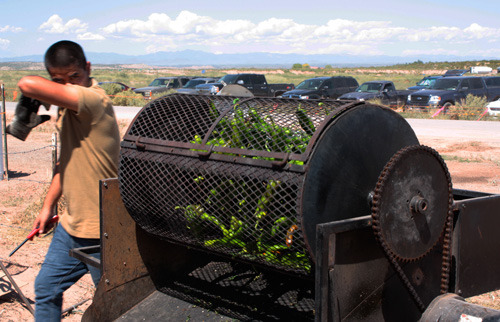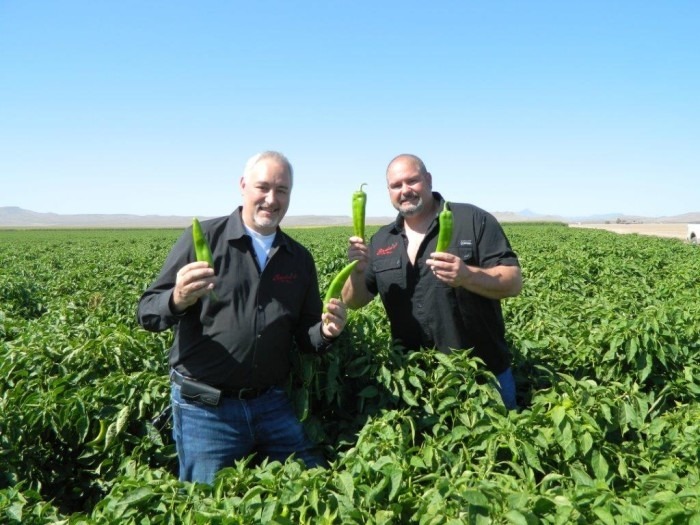The Dramatic World Of The New Mexican Green Chile
It's green chile season in New Mexico, a time when the smell of freshly roasted chilies permeates the air across the Land of Enchantment, as locals celebrate the return of this honored capsicum. But while New Mexicans and fans from the surrounding states get ready to indulge in this large, meaty pepper, much of the rest of the country has no idea what it's all about. For many people, the green chile means a jalapeño, poblano or — even worse in the minds of purists — the imposter chilies sold by companies trying to capitalize on the fame of their beloved New Mexican staple.
"Green jalapeños from Mexico are our biggest competitor, and China is the biggest competitor for red chilies," says Paul Bosland of the Chile Pepper Institute at New Mexico State University in Las Cruces. "We at the university are trying to educate people that if you want the right flavor, you need to pick the right cultivar."
This is why New Mexico sought out protection for its hallowed chile by enacting the New Mexico Chile Advertising Act in 2011 and by securing a federal trademark for "New Mexico Certified Chile" in 2014. The former statute makes it illegal for someone to "knowingly advertise, describe, label or offer for sale chile peppers as New Mexico chile, or to advertise, describe, label or offer for sale a product as containing New Mexico chile, unless the chile peppers in the product were grown in New Mexico." But even with this legal protection in place, there isn't much done by the state's Department of Agriculture to support the authentication of this prized fruit.

Even fiercely local marketers who want to sell New Mexico chile exclusively may have a hard time doing so in the current climate. Last year's lagging chile crop meant that the Hatch Chile Co., makers of canned Hatch Chile, had to supplement its usually 100 percent New Mexican product with chilies from Mexico — something the company hopes won't happen again, according to a rep.
"The demand is so high that the market is closed and it's hard to get a certified New Mexican chile," says Jim Garcia, a chile expert and hospitality consultant. "We have to use Mexican chilies now because that's what happens when you run out of local chilies in November and December."
Right now, the New Mexican chile industry makes about $400 million annually and brings in between 5,000 and 10,000 people to help with the harvest in August. While this may seem like a heavy production, it has actually declined over the last 10 to 15 years. The amount of land dedicated to chile production has dwindled as well, down from approximately 27,000 acres in years past to around 9,000 fields today. Garcia says part of the drop is due to the fact that chile is a "one-crop crop," meaning it only has a single, 120-day turn and then the land is useless for eight months. Other contributing factors to the decrease come from overfarming and good old-fashioned labor disputes.
The origin of the famous pepper stems from the academic horticulturist Fabian Garcia of the University of New Mexico. In 1921, he helped release the New Mexico No. 9, a chile cultivar that was pest-resilient and had less heat in order to appeal to the non-Hispanic people in the area.
"Farmers loved it and people loved it, so the farmers continued to grow it," says Bosland. "This chile became the basis for all the Mexican food in the United States."
Now you find different variations of the same strain, including the common Big Jim, Fandia Select and the New Mexican Heritage 64. Each of these were developed by the Chile Pepper Institute and were carefully cultivated to give the peppers the same characteristics of the original.
"It's a trend across the United States to embrace the green chile," says Bosland. "Now people are realizing that a bell pepper, a jalapeño and the New Mexican green chile do taste different."

Today, the New Mexican green chile remain a staple in the Southwestern diet, and for some people, like William R. Safford, co-owner of his family's mini restaurant chain Sadie's of New Mexico, it's life. The family uses around 1,000 pounds per week in its four locations, and to Safford, using a chile from another region isn't an option.
"We have always used chile from the Hatch region, and that goes back 60 years," he says. "It's the consistency, it's how it's grown and the relationship we have with the farmers. I can't imagine anything else."

